Input interpretation

HCOOH (formic acid) ⟶ H_2O (water) + CO (carbon monoxide)
Balanced equation
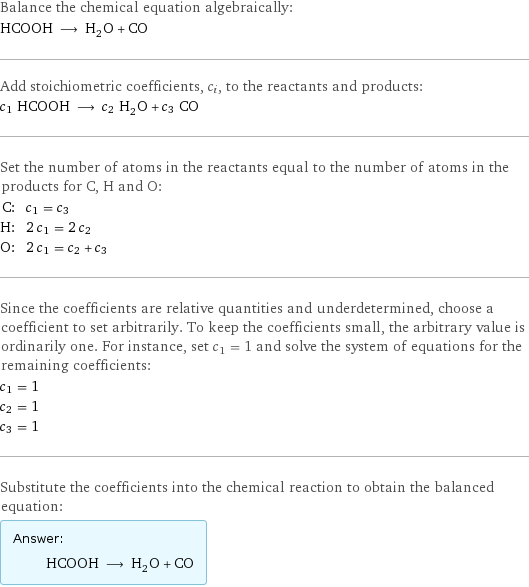
Balance the chemical equation algebraically: HCOOH ⟶ H_2O + CO Add stoichiometric coefficients, c_i, to the reactants and products: c_1 HCOOH ⟶ c_2 H_2O + c_3 CO Set the number of atoms in the reactants equal to the number of atoms in the products for C, H and O: C: | c_1 = c_3 H: | 2 c_1 = 2 c_2 O: | 2 c_1 = c_2 + c_3 Since the coefficients are relative quantities and underdetermined, choose a coefficient to set arbitrarily. To keep the coefficients small, the arbitrary value is ordinarily one. For instance, set c_1 = 1 and solve the system of equations for the remaining coefficients: c_1 = 1 c_2 = 1 c_3 = 1 Substitute the coefficients into the chemical reaction to obtain the balanced equation: Answer: | | HCOOH ⟶ H_2O + CO
Structures

⟶ +
Names

formic acid ⟶ water + carbon monoxide
Reaction thermodynamics
Enthalpy
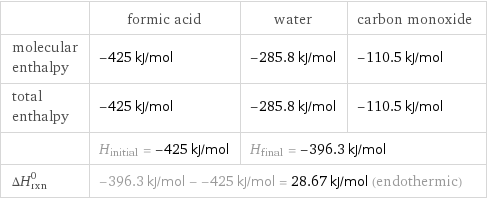
| formic acid | water | carbon monoxide molecular enthalpy | -425 kJ/mol | -285.8 kJ/mol | -110.5 kJ/mol total enthalpy | -425 kJ/mol | -285.8 kJ/mol | -110.5 kJ/mol | H_initial = -425 kJ/mol | H_final = -396.3 kJ/mol | ΔH_rxn^0 | -396.3 kJ/mol - -425 kJ/mol = 28.67 kJ/mol (endothermic) | |
Gibbs free energy
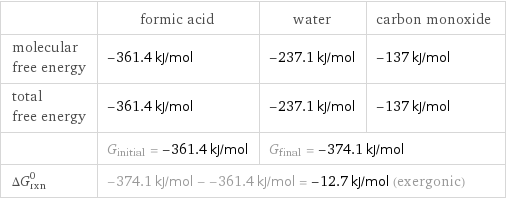
| formic acid | water | carbon monoxide molecular free energy | -361.4 kJ/mol | -237.1 kJ/mol | -137 kJ/mol total free energy | -361.4 kJ/mol | -237.1 kJ/mol | -137 kJ/mol | G_initial = -361.4 kJ/mol | G_final = -374.1 kJ/mol | ΔG_rxn^0 | -374.1 kJ/mol - -361.4 kJ/mol = -12.7 kJ/mol (exergonic) | |
Entropy
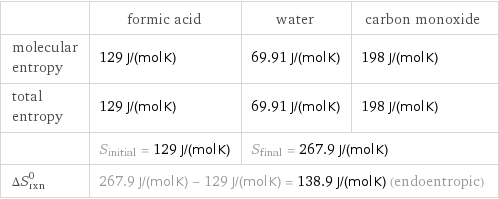
| formic acid | water | carbon monoxide molecular entropy | 129 J/(mol K) | 69.91 J/(mol K) | 198 J/(mol K) total entropy | 129 J/(mol K) | 69.91 J/(mol K) | 198 J/(mol K) | S_initial = 129 J/(mol K) | S_final = 267.9 J/(mol K) | ΔS_rxn^0 | 267.9 J/(mol K) - 129 J/(mol K) = 138.9 J/(mol K) (endoentropic) | |
Equilibrium constant
![Construct the equilibrium constant, K, expression for: HCOOH ⟶ H_2O + CO Plan: • Balance the chemical equation. • Determine the stoichiometric numbers. • Assemble the activity expression for each chemical species. • Use the activity expressions to build the equilibrium constant expression. Write the balanced chemical equation: HCOOH ⟶ H_2O + CO Assign stoichiometric numbers, ν_i, using the stoichiometric coefficients, c_i, from the balanced chemical equation in the following manner: ν_i = -c_i for reactants and ν_i = c_i for products: chemical species | c_i | ν_i HCOOH | 1 | -1 H_2O | 1 | 1 CO | 1 | 1 Assemble the activity expressions accounting for the state of matter and ν_i: chemical species | c_i | ν_i | activity expression HCOOH | 1 | -1 | ([HCOOH])^(-1) H_2O | 1 | 1 | [H2O] CO | 1 | 1 | [CO] The equilibrium constant symbol in the concentration basis is: K_c Mulitply the activity expressions to arrive at the K_c expression: Answer: | | K_c = ([HCOOH])^(-1) [H2O] [CO] = ([H2O] [CO])/([HCOOH])](../image_source/2e2ba5609a56fe4adff2a4dbe4dde018.png)
Construct the equilibrium constant, K, expression for: HCOOH ⟶ H_2O + CO Plan: • Balance the chemical equation. • Determine the stoichiometric numbers. • Assemble the activity expression for each chemical species. • Use the activity expressions to build the equilibrium constant expression. Write the balanced chemical equation: HCOOH ⟶ H_2O + CO Assign stoichiometric numbers, ν_i, using the stoichiometric coefficients, c_i, from the balanced chemical equation in the following manner: ν_i = -c_i for reactants and ν_i = c_i for products: chemical species | c_i | ν_i HCOOH | 1 | -1 H_2O | 1 | 1 CO | 1 | 1 Assemble the activity expressions accounting for the state of matter and ν_i: chemical species | c_i | ν_i | activity expression HCOOH | 1 | -1 | ([HCOOH])^(-1) H_2O | 1 | 1 | [H2O] CO | 1 | 1 | [CO] The equilibrium constant symbol in the concentration basis is: K_c Mulitply the activity expressions to arrive at the K_c expression: Answer: | | K_c = ([HCOOH])^(-1) [H2O] [CO] = ([H2O] [CO])/([HCOOH])
Rate of reaction
![Construct the rate of reaction expression for: HCOOH ⟶ H_2O + CO Plan: • Balance the chemical equation. • Determine the stoichiometric numbers. • Assemble the rate term for each chemical species. • Write the rate of reaction expression. Write the balanced chemical equation: HCOOH ⟶ H_2O + CO Assign stoichiometric numbers, ν_i, using the stoichiometric coefficients, c_i, from the balanced chemical equation in the following manner: ν_i = -c_i for reactants and ν_i = c_i for products: chemical species | c_i | ν_i HCOOH | 1 | -1 H_2O | 1 | 1 CO | 1 | 1 The rate term for each chemical species, B_i, is 1/ν_i(Δ[B_i])/(Δt) where [B_i] is the amount concentration and t is time: chemical species | c_i | ν_i | rate term HCOOH | 1 | -1 | -(Δ[HCOOH])/(Δt) H_2O | 1 | 1 | (Δ[H2O])/(Δt) CO | 1 | 1 | (Δ[CO])/(Δt) (for infinitesimal rate of change, replace Δ with d) Set the rate terms equal to each other to arrive at the rate expression: Answer: | | rate = -(Δ[HCOOH])/(Δt) = (Δ[H2O])/(Δt) = (Δ[CO])/(Δt) (assuming constant volume and no accumulation of intermediates or side products)](../image_source/dffc95c83ce62c987c0cebe434f008ae.png)
Construct the rate of reaction expression for: HCOOH ⟶ H_2O + CO Plan: • Balance the chemical equation. • Determine the stoichiometric numbers. • Assemble the rate term for each chemical species. • Write the rate of reaction expression. Write the balanced chemical equation: HCOOH ⟶ H_2O + CO Assign stoichiometric numbers, ν_i, using the stoichiometric coefficients, c_i, from the balanced chemical equation in the following manner: ν_i = -c_i for reactants and ν_i = c_i for products: chemical species | c_i | ν_i HCOOH | 1 | -1 H_2O | 1 | 1 CO | 1 | 1 The rate term for each chemical species, B_i, is 1/ν_i(Δ[B_i])/(Δt) where [B_i] is the amount concentration and t is time: chemical species | c_i | ν_i | rate term HCOOH | 1 | -1 | -(Δ[HCOOH])/(Δt) H_2O | 1 | 1 | (Δ[H2O])/(Δt) CO | 1 | 1 | (Δ[CO])/(Δt) (for infinitesimal rate of change, replace Δ with d) Set the rate terms equal to each other to arrive at the rate expression: Answer: | | rate = -(Δ[HCOOH])/(Δt) = (Δ[H2O])/(Δt) = (Δ[CO])/(Δt) (assuming constant volume and no accumulation of intermediates or side products)
Chemical names and formulas

| formic acid | water | carbon monoxide formula | HCOOH | H_2O | CO Hill formula | CH_2O_2 | H_2O | CO name | formic acid | water | carbon monoxide
Substance properties
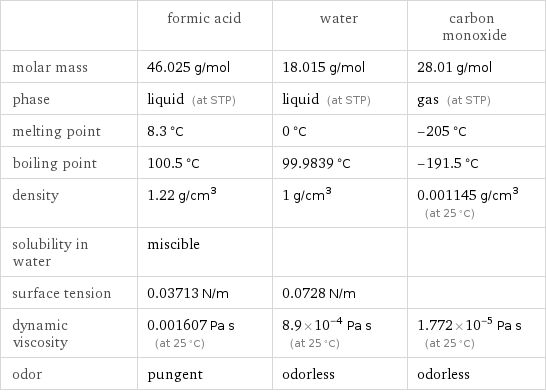
| formic acid | water | carbon monoxide molar mass | 46.025 g/mol | 18.015 g/mol | 28.01 g/mol phase | liquid (at STP) | liquid (at STP) | gas (at STP) melting point | 8.3 °C | 0 °C | -205 °C boiling point | 100.5 °C | 99.9839 °C | -191.5 °C density | 1.22 g/cm^3 | 1 g/cm^3 | 0.001145 g/cm^3 (at 25 °C) solubility in water | miscible | | surface tension | 0.03713 N/m | 0.0728 N/m | dynamic viscosity | 0.001607 Pa s (at 25 °C) | 8.9×10^-4 Pa s (at 25 °C) | 1.772×10^-5 Pa s (at 25 °C) odor | pungent | odorless | odorless
Units
